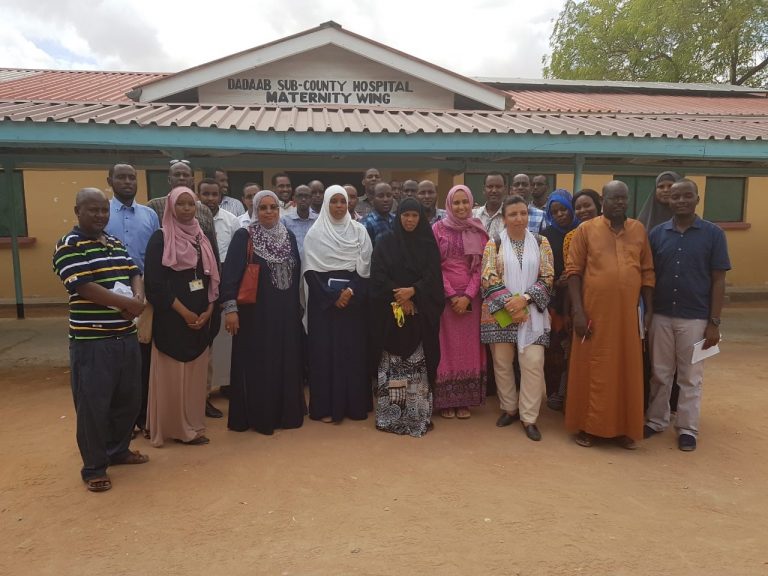Since 1991, Somalis have left their country in successive waves, fleeing civil conflict, drought, and related famines. In 2017, the Dadaab Refugee Complex in Eastern Kenya, was comprised of five separate camps hosting 239,549 refugees, with Somalis making up 96% of the refugee population.[1]
Health care services in Dadaab camps are overseen by UNHCR and provided free-of-charge through a range of non-governmental organizations (NGO) partners that operate 16 health posts, four hospitals, and one stand-alone maternity centre, in addition to community outreach services. Providing health and other services in the camps is constrained for a number of reasons. Security issues, including kidnappings of humanitarian aid staff, improvised explosive devices, and attacks on refugee leaders and Kenyan police, have heightened security restrictions and make aid provision challenging.[2]
Kenya has been host to one of the largest refugee camps in the world, with near 235,269 registered refugees and asylum seekers in 2018. In both camps and around the country, the population experiences cyclic humanitarian situations caused by conflict, harsh climatic conditions, population movements and disease outbreaks; and continue to record poor outcomes for newborns. Countrywide, the percentage of newborn deaths for all under-five deaths in 2015 was 46%, and the newborn mortality rate was 21 deaths per 1,000 live births. 28% of neonatal deaths in Kenya in 2017 were due to preterm birth complications.
With the financial and technical support from UNICEF ESAR, UNICEF Kenya collaborated with the National and County Ministries of Health to conduct an orientation workshop with key stakeholders such as UNHCR, Médecins Sans Frontières, International Rescue Committee, and Red Cross Kenya. This workshop would be the catalyst for informing health professionals about the efforts taking place to address newborn health in humanitarian settings, held from April 2nd to 4th in Dadaab Camp, Garissa County.
The workshop was attended by 30 participants, local NGOs working as implementing partners, neonatologists and obstetricians representing county health offices, and professionals from EPI, WASH, M&E, EMOPS, Gender and Nutrition sectors. Two counties, including Garissa and Wajir, were part of this dissemination workshop. For real life exposure, participants were taken to the sub-county hospital, where they realized newborn health was a missing component of the health care provision.
The workshop enabled participants and supporting organizations to achieve the following:
- Educate participants on the Newborn Humanitarian Guide and draft Global Newborn Strategy for Newborn Humanitarian Settings (2020-2025)
- Flagging up of newborn health in health programming and refocusing on low-cost high-impact interventions.
- Discuss the results of the SWOT analysis
- Become sensitized to the needs of newborns in both development and humanitarian settings
- Prioritize plan of action for Wajir and Garissa county and some of the action points were as follows:
- Strengthen provision of quality MNH service by Health care providers in the HFs
- Provide Mentorship to the services providers
- Strengthen Newborn data for decision making
- Strengthen MNH policy environment and research
- Come to a consensus on the inclusion of newborn health in the national emergency preparedness plans
At the conclusion of the workshop, Ms. Isnino Rage, Chief officer of Health Garissa County commented: “We are grateful to UNICEF for providing technical and financial support in order to disseminate these guidelines, to get familiarized with key newborn interventions in humanitarian setting like ours, aimed to reduce neonatal mortality. Moving forward, the health sector under the County government stewardship is committed to ensuring our health facilities achieve accelerated reduction of neonatal mortality as well as maternal mortality. I call upon all health implementers here to scale up neonatal services as key priority and aggressively target key drivers of mortality and make necessary investment for our newborns.”
With these achievements, workshop participants will be able to implement the necessary changes to properly address the newborn health challenges in their humanitarian settings. UNICEF field teams will be following up with counties on their progress.
Acknowledgements: We are grateful for the generosity of the Government of the Kingdom of the Netherlands’s seed fund to UNICEF ESAR for protecting and empowering children on the move.
[1] UNHCR. Refugees and asylum seekers in Kenya. 2017. Available from: http://www.unhcr.org/ke/wp-content/uploads/sites/2/2017/10/Kenya-statistics-package-Sept_2017.pdf. Accessed 18 Oct 2017.
[2] Gee S, Vargas J, Foster AM. “The more children you have, the more praise you get from the community”: exploring the role of sociocultural context and perceptions of care on maternal and newborn health among Somali refugees in UNHCR supported camps in Kenya. Confl Health. 2019;13:11. Published 2019 Mar 29. doi:10.1186/s13031-019-0195-z
